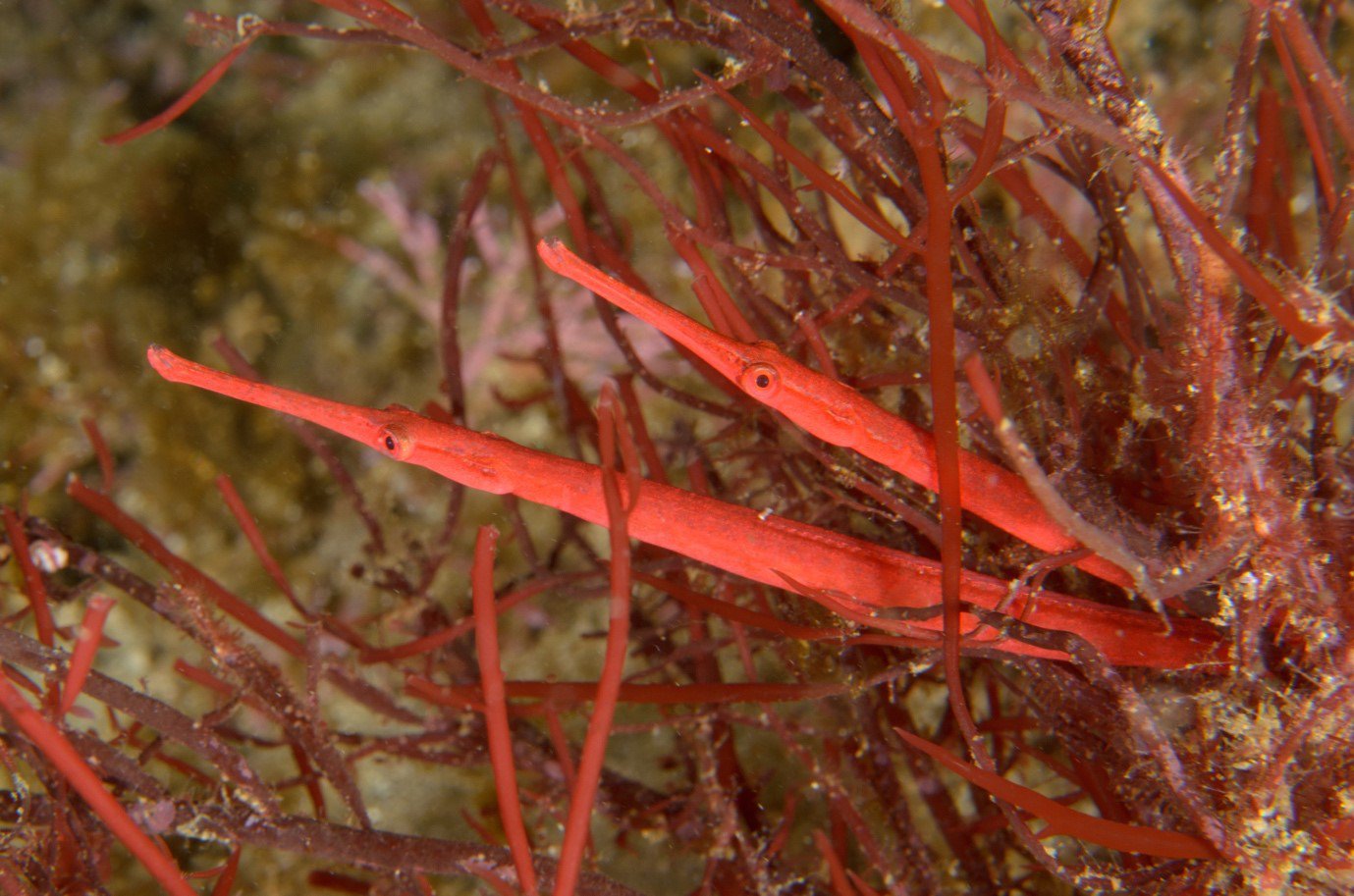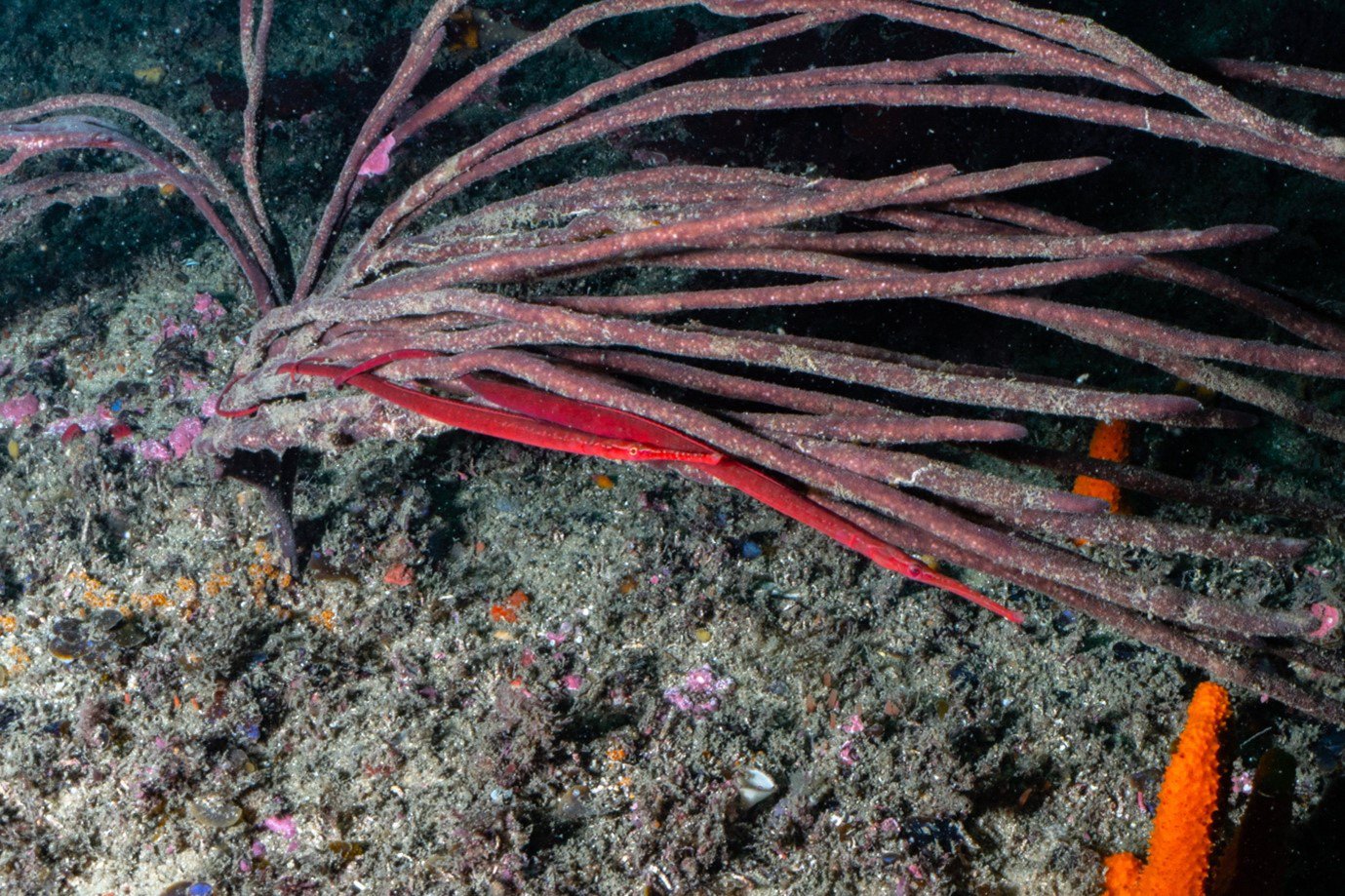Meet the spectacular Red Wide-bodied Pipefish: Australia's newest endemic fish species
Australian Museum scientists have identified a new pipefish species under the waves of our biggest city. Australia’s newest endemic fish species was found hiding in plain sight at a popular Sydney dive spot!
The Red Wide-bodied Pipefish is the fourth member of the genus Stigmatopora to be described from southern Australia (S. nigra, S. argus, S. narinosa and S. harsastii). It inhabits semi-exposed bay entrances and ocean embayments in sandy areas, interspersed amongst rocky reefs at depths of 12-25 metres. Most notably, it associates with finger sponges and red algae in contrast to the other members of Stigmatopora that associate with brown algae and seagrass in shallow coastal and estuarine habitats.

Stigmatopora harastii in situ, male-female pair. The Steps, Kurnell, Botany Bay, NSW, Australia, 13.5 meters depth, 18 June 2020.
Image: Andrew Trevor-Jones© Andrew Trevor-Jones
The scientific name of the Red Wide-bodied pipefish, Stigmatopora harastii, is named in honour of David Harasti, a Senior Research Scientist with NSW DPI Fisheries whose research focus is on marine threatened species including White’s Seahorse, Hippocampus whitei, and the scientist who spotted this species in 2002. David, along with other scuba divers, reported a red pipefish associating with pale red finger sponges at 18 metres depth in Jervis Bay that year. It was subsequently reported occurring at Bass Point, Shellharbour, NSW in red algae at 18 metres depth in 2017. David and I realised it represented a new species of Stigmatopora based on the unique colour, habitat and depth in which it was found. Like all members of Stigmatopora, the new species has a long snout and thread-like prehensile tail; however, it exhibits red body colouration versus green colouration seen in other species of the genus.
Local Sydney diver, underwater photographer and Australian Museum scientist Andrew Trevor-Jones, was contacted to determine if the red pipefish occurred at his regular dive sites. Andrew frequently documents the presence of other Syngnathids including pygmy pipehorses, seahorses, seadragons and pipefish at the popular dive spots the Leap and the Steps at Kurnell, Botany Bay. He hadn’t personally seen any but had heard from other divers, so Andrew took on the challenge to find them. It took three months of searching until Andrew was successful in finding a few individuals. Without a dive torch it was impossible to observe them as their red colouration and body oriented in parallel to the single red algal fronds, made them extremely well-camouflaged. The habitat was subject to strong surge as individuals of S. harastii and the red algae together were observed swaying in unison with the surge. The Red Wide-bodied Pipefish was also seen at the northern entrance to Botany Bay at the dive site known as Minmi Trench in pale red finger sponges at 18 metres depth.

Stigmatopora harasti in situ, male-female pair in finger sponge. Minmi Trench, Botany Bay, NSW, Australia, 18 meters depth, 17 February 2019.
Image: Duncan Heuer© Duncan Heuer
So how did we identify this news species? We used a combination of DNA analysis, morphological characteristics, and colour patterns. Stigmatopora harastii and the Widebody Pipefish, Stigmatopora nigra appear superficially similar, however genetic analysis suggests they arose from a common ancestor 12.2 million years ago. Morphologically, S. harastii and S. nigra differ in a very subtle character; the latter exhibits a thin bony head ridge that extends from the head into the first trunk ring, however they differ dramatically in colour patterns which makes it easy to tell them apart underwater. Stigmatopora harastii exhibits red body background colouration, unlike green or brown in S. nigra. Additionally, S. harastii exhibits a large cluster of red dots on its ventral surface versus dark black bands in S. nigra.
Five species of Stigmatopora, occur in temperate Australia and New Zealand: S. nigra, S. argus, S. narinosa, S. harsastii and S. macropterygia (New Zealand). The recent discovery of a new species of charismatic fish in coastal waters near a major metropolitan city underscores how little we still know about the biodiversity of fishes in the family Synganthidae in southern Australia. It would not be surprising to find additional undescribed species of Stigmatopora in other unique habitats throughout southern Australia and even in New Zealand in future fish surveys.
Graham Short, Research Associate, Ichthyology, Australian Museum Research Institute.
Listed as one of the top ten remarkable new marine species from 2020
The Red Wide-bodied Pipefish has been named as one of the top-ten marine species of 2020 by the World Register of Marine Species - the only fish and Australian institution to make this year’s list. This colourful new species of pipefish has been chosen for the Top-Ten for its clever camouflage, among red algae and sponges, and the fact that it has been described from Sydney’s underwater doorstep, a popular dive site where it has been hiding for years without anyone realising. For more information, please go to: https://lifewatch.be/en/2021.03.19-WoRMS-LifeWatch-press-release
More information
- Short G & Trevor-Jones A (2020) Stigmatopora harastii, a new species of finger sponge and red algae associating pipefish from New South Wales, Australia (Teleostei, Syngnathidae). Zookeys, https://doi.org/10.3897/zookeys.994.57160
- Parkinson, K. 2020. Red Wide-bodied Pipefish, Stigmatopora harastii Short & Trevor-Jones, 2020. Australian Museum Animal Factsheet.
















